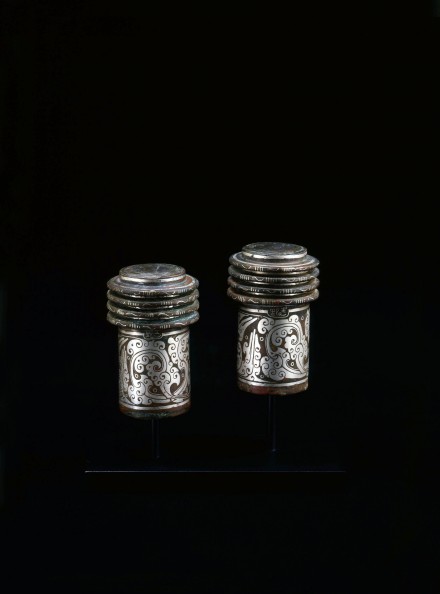J.J. Lally & Co., Oriental Art / New York City, New York
MenuPast Exhibition
Bronze and Gold in Ancient China
March 24 - April 12, 2003

15.
A PAIR OF INSCRIBED SILVER-INLAID BRONZE CHARIOT FITTINGS
Late Warring States Period/Early Western Han Dynasty
3rd/2nd Century B.C.
each tubular finial with four horizontally projecting rings surmounted by an inset platform top, lavishly inlaid in silver with swirling stylized cloud forms embellished with cut-out scroll motifs and interspersed with tiny inlaid ringlets all around the straight sides, the top inlaid with trefoil petal motifs and the edges of the raised rings inlaid with clusters of vertical lines separated by serpentine scroll motifs, the upper border of the main frieze interrupted by a reserved panel inlaid with two characters.
Heights 2 3⁄4 inches (7.1 cm)
The two inlaid silver characters on each fitting may be read as "Ling li", which may be interpreted as the name of a locality in ancient China.
A very similar pair of chariot fittings, inlaid with the same inscription, are illustrated by Krahl, Sammlung Julius Eberhardt/ Collection Julius Eberhardt, Frühe chinesische Kunst/ Early Chinese Art, Hong Kong, 1999, p. 125, no. 58, where the author notes that “Lingli is the name of a road at Maoling, the mausoleum of Emperor Han Wudi (r. 141-87 B.C.) near Xi’an in Shaanxi province, for whom these fittings appear to have been made.”
A silver-inlaid bronze fitting of very similar form and design which is inscribed "Ling li Guo shi", which may be read as "Guo family of Lingli", is illustrated by Palmgren in Selected Chinese Antiquities from the Collection of Gustaf Adolf, Crown Prince of Sweden, Stockholm, 1948, pl. 108, no. 5, described on p. 142. Compare also the pair of smaller and less elaborate bronze finials inlaid with similar volutes in gold and silver also inscribed "Ling li Guo shi", illustrated by Li Xueqin in The Glorious Traditions of Chinese Bronzes, Singapore, 2000, pp. 205 and 206, no. 93 d and e, where the author states that "Lingli was the name of a district (li) in the Western Han capital of Chang'an" and cites the "Biography of Wan Shijun" in the Han shu (a history of the Han Dynasty compiled during the Han period) as the reference for this interpretation.
Another silver-inlaid bronze finial of very similar form and design without inscription, exhibited in London in 1991 at Eskenazi Ltd; is illustrated in their catalogue Inlaid Bronzes and Related Material from pre-Tang China, no. 20, together with a gold-and-silver-inlaid bronze axel cap inscribed with two inlaid characters which may be read as "Ling li", in the same catalogue, no. 19.
15.
A PAIR OF INSCRIBED SILVER-INLAID BRONZE CHARIOT FITTINGS
Late Warring States Period/Early Western Han Dynasty
3rd/2nd Century B.C.
Heights 2 3⁄4 inches (7.1 cm)